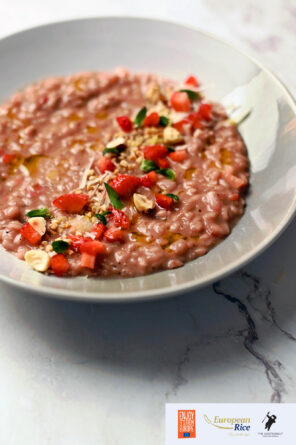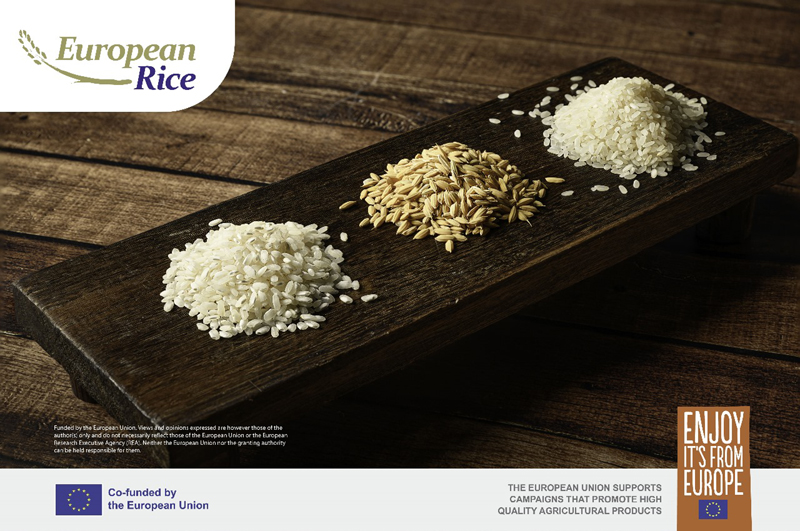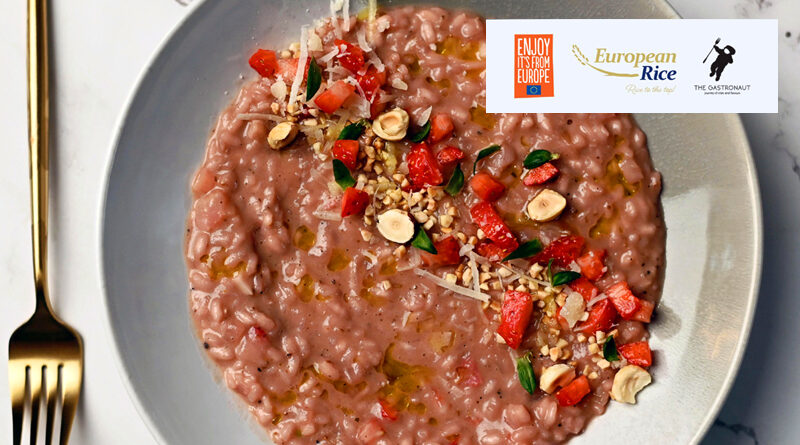WORLD FOOD TRAVEL DAY: EUROPEAN RICE RECIPE
European Rice is high quality rice grown in Greece since the 1950s and other European countries. There are two varieties: Indica Rice (long rain) and Japonica Rice (medium grain). European Rice has a high nutritional value, being rich in B vitamins, such as Niacin, Thiamine, Riboflavin and Selenium.
The EU is both self-sufficient and a net exporter of Japonica rice. All European rice complies with the Integrated Quality Management System for the Agricultural Production of Rice, which is based on good agricultural practices which respect the environment, protect the producer-grower’s health and offer a healthy and safe product for consumers. For more information see: europeanrice.eu
Strawberry Rice Recipe using European Rice
Chef Homam Ayaso (aka @homamayaso) is on a journey to create six bespoke recipes using premium European Rice, in his new series ‘Everything Rice’, and here is one to tickle the taste buds.
Strawberry Pilaf or Strawberry Rice is an unusual, fresh and colourful, recipe. It’s delicious, a little bit different, and very easy to make – perfect for a special occasion.
 Prep Time: 15 Min
Prep Time: 15 Min
Cook Time: 20 Min
Servings: 4
Ingredients:
2 shallot onions
3 cloves of garlic
1 litre of vegetable broth
100ml (1/2 cup) of vegan white wine
350g (1 3/4 cup) of premium quality European Rice
350g (1 1/2 cup) of strawberries
40g of vegan butter
50g (1/2 cup) grated Vegan Parmigiano (optional)
3 tablespoons of extra virgin olive oil
Salt and pepper
Nutmeg
Roasted hazelnut to garnish
Instructions:
First prepare a vegetable stock, if you don’t already have it. Vegetable stock should not be too aromatic. Carrot, celery and a small onion in 1.5 litres of lightly salted water is enough. Boil for at least 40 minutes. You are going to use the broth to cook the risotto, slowly, letting the rice absorb it little-by-little. Meanwhile, wash the strawberries then dry them well. Remove the green tuft and cut t

hem into small pieces. Keep a few whole strawberries for the final decoration.
Chop the onion and garlic then sauté over a medium heat in a pan with 3 tablespoons of extra virgin olive oil. Add the rice and cook for 2-3 minutes, stirring constantly, until the grains are slightly glassy.
Then add the white
wine, stir and let it evaporate, over a high heat. Then add hot vegetable stock with a ladle. At first, there will be a sizzle as part of the stock, in contact with the hot pan, evaporates. Immediately add another ladle of stock. During cooking, the rice must always be covered with stock; in this way it releases the starches and the grain does not break.
Halfway through cooking, after about 8 minutes, add half of the chopped strawberries, stirring constantly. The strawberries will become creamy and give the rice its characteristic colour.
When the rice is cooked, after another 8-10 minutes, turn off the heat. Add grated vegan Parmigiano cheese and butter. Stir to combine and finish by decorating with the remaining strawberries and roasted hazelnut.

High standards are set for European rice
European rice is distinguished for its quality and nutritional value. This is due to high-quality standards being applied to production methods. This results in a quality product, free from plant protection products (like chemical pesticides and herbicides) and other heavy metals which are detrimental to human health.
It is super environmentally-friendly
Of course, a European country importing European Rice means it has a lower carbon footprint but there is so much more to the eco-credentials than you might think.
For example, precision agriculture is on the rise with respect to growing European rice. This particular farming management concept is compatible with the ecological approach measures stipulated in the new, reformed Common Agricultural Policy. Its goal is to further improve the quality and yield and simultaneously reduce soil and underground water pollution, as well as mitigating wider environmental impacts.
It’s great for biodiversity
Rice cultivations expand freshwater habitats in the region, principally during summer, and the rice paddies function as artificial seasonal wetlands, complementing the natural ecosystem. During May, rice paddies are flooded with water and ready for rice seeds. The flooded fields are filled with small spineless organisms and amphibians, attracting many birds, such as little egrets, black-crowned night herons, ibises, seagulls and other birds, looking for food, for themselves and their hatchlings.
Disclaimer: Funded by the European Union. Views and opinions expressed are however those of the author(s) only and do not necessarily reflect those of the European Union or the European Research Executive Agency (REA). Neither the European Union nor the granting authority can be held responsible for them.

